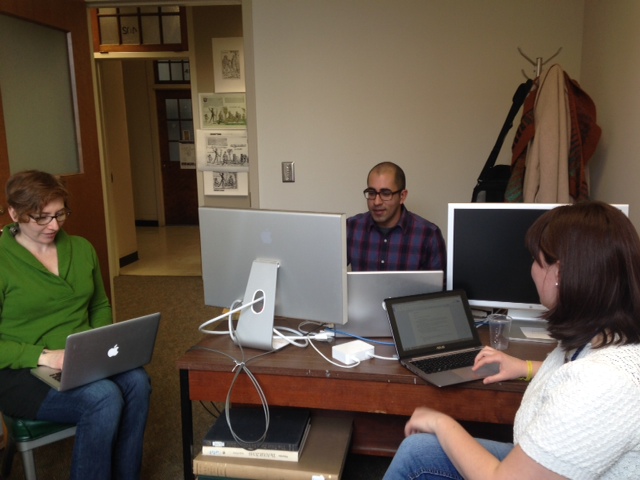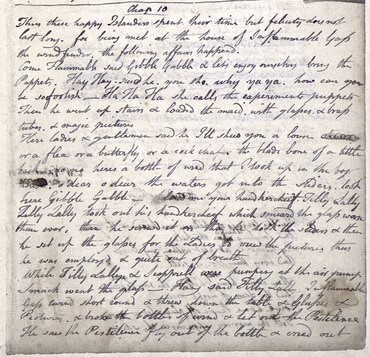Welcome to BAND’s 2014 Day of DH post where we answer the question, “just what do digital humanists do?”

Sitting from left to right: Megan, Laura, Eric, Hardeep, Rachel, Sarah, Morris, Kylie, Shannon, Lisa, Nick.
The Blake Archive has editors and assistants working at various campuses around the US, including a group at the University of Rochester. In residence at the University of Rochester, we have:
- Morris Eaves, co-editor of the William Blake Archive
- Amber Bertin, MA student (Film and Media Preservation) and project assistant
- Abby Brengle, PhD student (English) and project assistant
- Shannon Jaime PhD student (English) and project assistant
- Sarah Jones, Managing Editor, Blake/An Illustrated Quarterly
- Rachel Lee, Lecturer (Writing, Speaking and Argument Program)
- Eric Loy, PhD student (English) and project assistant
- Kylie Regan, MA student (English) and project assistant
- Margaret Speer, BA student (English and Cultural and Intellectual History) and project assistant
- Hardeep Sidhu, PhD student (English) and project assistant
- Lisa Vandenbossche, PhD student (English) and project assistant
- Nikolaus Wasmoen, PhD student (English) and project assistant
- Laura Whitebell, PhD student (English) and project coordinator
- Megan Wilson, BA student (English) and project assistant
Working off-site, we have:
- Andrea Everett, PhD student (English) and project assistant
- Ali McGhee, PhD student (English) and project assistant
The Blake Archive team at the University of Rochester, affectionately known as BAND (Blake Archive, Northern Division) collaboratively authored this post.
Kylie
I’m currently working on proofing the transcriptions of a seven-object series of fragments from William Blake’s poetic work, entitled “Woe cried the muse” and “then she bore pale desire.” Proofing involves checking that all of the elements (title, digital images, image dimensions) of the works are displaying correctly and ensuring that the functional aspects of the web pages (links between the digital image and the transcription, links to related works in the Archive, the zoom function) work properly. Of course, the more difficult work comes in double-checking the transcription, which is particularly interesting for these pieces because they include many of Blake’s cross-outs and additions, as well as marks by Blake’s editor William Michael Rossetti as he prepared the manuscripts for publication.
While working on this project, I have been using a pre-made Proofing Sheet that lists the various elements of the documents that need to be checked. The Sheet currently exists as a Googledoc so that suggested changes can be listed for review before being implemented on the Archive’s web pages. I am making notations as I run into problems with the proofing, particularly with the more detailed sections of the transcription checks, to record ideas for potential improvements to this form.
Abby:
Team Color Code (Rachel, Hardeep and Laura)
Three BAND members make up Team Color Code; our primary task is to revisit the Blake Archive’s tag set for encoding manuscripts and the current color-coded transcription display, and evaluate whether they will be adequate for more complicated manuscripts, such as Blake’s Notebook or the unpublished manuscript Vala, or the Four Zoas. After toying with tracing paper and colored pencils, in addition to mock-ups of different displays in HTML, we’ve recently discovered some documentation for a TEI (Text Encoding Initiative) module for genetic editing. The genetic editing module includes elements for describing stages of a text’s development, which we think might be extremely helpful when encoding some of Blake’s more complicated manuscripts, some of which he worked on for several years.
At our weekly Team Color Code meeting, we discussed our next steps for the project. We’ve been working with the University of Rochester’s Digital Humanities group and are planning a presentation about our progress with the genetic editing module, which we will also send to Blake Camp (our annual meeting with the whole Blake Archive team). One of the problems of working on a long-term project is striking a balance between updating people and reminding them of any necessary background information, so we talked about how best to present our work.
Sitting from left to right: Rachel, Hardeep, Laura
Shannon
At the moment I am tracing the Work and Provenance Info for Blake’s 1806 letter to Sir Richard Phillips’ Monthly Magazine. Since this letter is a typographical work without an original manuscript, it can be difficult to use the standard source references to fill in the gaps. (BAND has encountered issues like this before while preparing the Gilchrist letters for publication.) Beyond trying to pin down the exact composition date of the letter (which was published in the magazine on July 1, 1806 but most likely written in June yet encoded in the XML as may1806), I’ve found creative ways to research information using various bibliographic and electronic sources. As of the Day of DH, my search continues.
Laura:
Starting #DayofDH off right in the @blakearchive http://t.co/TXLqsfANDi
— Laura Whitebell (@madameyucca) April 8, 2014
An exciting part of the transcription process: putting works in progress on the @BlakeArchive testing site! #DayofDH pic.twitter.com/COJ7mEjya9
— Laura Whitebell (@madameyucca) April 8, 2014
Morris:
Eric Loy, the Blake Archive, and the Mellon Digital Humanities Program at the University of Rochester
The Day of DH is an opportune moment to congratulate the Archive’s own Eric Loy, a first-year PhD student in English. He and 3 other students from the departments of History and of Art and Art History/Visual and Cultural Studies are the first recipients of 2-year Mellon graduate fellowships in the digital humanities. (Four more fellowships will be awarded next year to create a running cohort of 8.) The new graduate DH program at Rochester is funded in part by a $1 million, 4-year grant from the Andrew W. Mellon Foundation that aims to unite advanced study in the humanities with the latest digital technology. So Eric will continue working on the Archive team (which qualifies as a “humanities lab” in the Mellon program) as he acquires other skills and experience and formulates plans for his PhD qualifying exams and dissertation research. As the director of the program, I’ll help to tailor each fellow’s training, coursework, teaching, and mentoring to individual needs and interests. For more information, see the original announcement: http://www.rochester.edu/news/show.php?id=7752
Eric:
Working on #DayofDH. First up: fixing <choice> elements in my XML for "Blake's Chaucer: The Canterbury Pilgrims." pic.twitter.com/lvA1TBFUT4
— Eric Loy (@eric_loy) April 8, 2014
Lisa:
I have been finishing up work on Genesis. Genesis is Blake’s last illuminated work before his death – in fact it remains unfinished because he died before completing it. The main text of the work is the King James’ Bible chapter of Genesis, to which Blake added chapter headings and images. We have decided to transcribe the text in its entirety.
Genesis as a digital archive project was started by Esther Arnold and then passed to me. Today I completed the project. The related works section was the last thing that had to be added. This information (as often is) was sent from the editors and I updated it on the info pages of the work. Genesis will now have to be proofed by someone on the BAND team, and I will make necessary revisions before it is ready for publication.
Margaret:
From Kentucky, where I was presenting a paper at a conference, I took a look at the Google Document that has served as guidance for proofreading the Archive materials–manuscript transcriptions, work information, etc.–on Tiriel. This was a document that the primary proofreaders of Tiriel created, and I’ve started to compare it to the Proofing Form we use to proofread Blake’s letters. I’m making notes about the different elements and functions of the two documents, and the inconsistencies and inadequacies of the forms to the formatting and materials of the Archive. The end project is a potential combination of these proofreading documents (possibly with some other materials) to create a generalized Proofing Form that would be applicable, useful, and efficient for reviewing all the different projects in the Archive, present and future.
Hardeep:
Today Laura Whitebell, Lisa Vandenbossche, and I met to discuss a new project: “The French Revolution”–a short typographical work published early in Blake’s career. We’re starting from scratch on this project, and today we went through the process of getting all of our materials in order. The first step in this process is creating a “BAD”:–the Blake Archive’s .xml file. From there, we’ll begin to enter information about the work (details about the material object; its provenance; etc.) and to transcribe the work itself.
I’m also at work on transcribing and encoding Blake’s receipts. Most of these are relatively short documents that contain details of sales of Blake’s works during his lifetime. Included in this collection is an “Accounts” ledger that spans many years and includes transactions between Blake and John Linnell. Formatting the “Accounts” objects requires a lot of trial-and-error: the object itself contains many columns and rows of text and prices that is difficult to reproduce in an accurate, readable way. Once I’m through with this transcription, I’ll continue collection the “work information” about the receipts.
Sarah:
Click here for Sarah’s post over at The Blake Quarterly blog.




